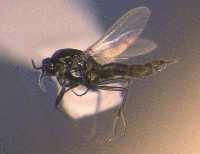 |

 Biting gnats, fire blight, tree borers,
vegetables
Biting gnats, fire blight, tree borers,
vegetables
By John Fulton
[May 23, 2011] Biting gnats -- Call them buffalo gnats, black flies and other unmentionable names, but they have returned. The small flies, or gnats, are hatched in clean, running water. This is one indicator our water protection plans are succeeding. They will continue to hatch until water temperatures hit about 75 degrees. They will also travel up to 10 miles in search of a food source, meaning blood.
|
These insects can produce serious welts when they decide to
bite. They tend to be worse during the day but are seldom a
problem inside buildings. In addition to people, they tend to attack birds. Young poultry and wild birds are especially vulnerable. Control is difficult. Sprays of malathion, permethrin or bifenthrin will help with controlling the buffalo gnats when outdoor activities must be held in infested areas. Dusts of permethrin will also help with outside poultry operations. Repellents of DEET, citronella and vanilla may also provide some relief. Remember, only the females bite, and the males swarm your face. When the bite occurs, a chemical is injected to help with blood flow. This is often the reason for the painful welts, usually on the face. Children also seem to be bitten, and affected, more than adults. The gnats seem to be attracted to white clothing. Navy blue seems to be their least favorite color. Fire blight Apple and pear trees are also having their problems. There is a large amount of tip dieback in some varieties, and this is probably fire blight. Look for a shepherd's crook at the tip of the affected areas as a clue it is fire blight. Usually the first symptom is one year's growth dying back. Fire blight is a bacterial disease; therefore, there is little chance for you to treat it. The common treatment in commercial operations is streptomycin, but it has to be applied before symptoms appear. Bordeaux mixture can also help prevent the disease. Prune out disease cankers when dormant. This disease cost Illinois its pear industry. Borer control Here is a listing of common borers and their control times: ash borers, early June and early July; bronze birch borer, mid-May and repeat two times at two-week intervals; dogwood borer, mid-May and mid-June; flat-headed apple borer, late May and repeat in three weeks; lilac borer, early June and early July; locust borer, late August and mid-September; mountain ash borer, early June and mid-July; peach tree borer, mid-June and mid-July; viburnum borer, early June and early July; and Zimmerman pine moth, April or August. The emerald ash borer, although not confirmed in our area at this time, has a control time in Michigan beginning in mid-May and runs through mid-July. The product of choice for many borers is now permethrin or bifenthrin. Imidicloprid, as a soil treatment, has some control of certain borers but can't be used on any fruit trees. Sevin (carbaryl) is the product of choice for most fruit trees and is applied directly to the trunk. Garden planting We are in the planting time for warm-loving vegetables, which is May 10 through June 1. Of course, the weather has been slow to cooperate this year. Warm-season vegetables include lima beans, cucumbers, eggplant, melons, pepper plants, sweet potato slips, pumpkins and squash. You can also put out successive plantings of snap beans, beets, carrots and sweet corn to extend the season. [By JOHN FULTON, University of Illinois Extension]
|
 |





